Video promotion on YouTube. SEO, analytics, charts and nuances
Hello!
My name is Zhenya Zaremba. I work in Wargaming video promotion specialist. In this article I would like to talk about the promotion of videos on YouTube, promotion schemes and the nuances that occur during the work. We have conducted many tests and I will be happy to share their results with you. Under the cut, I will tell you all about the main success factors of the video, SEO features on YouTube, work with analytics and other techniques.
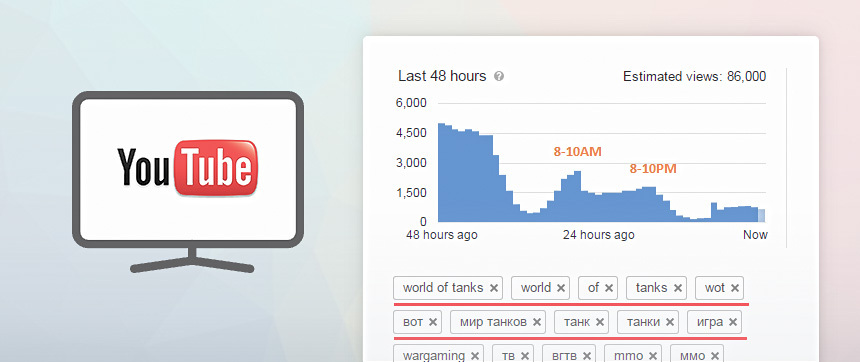
Retreat . We do not know 100% how the YouTube algorithm works. We did not create it and did not communicate with those who created it. We only analyzed a huge sample of videos and conducted tests. Fortunately, we have a lot of videos. Perhaps somewhere our conclusions are wrong. I will be happy to talk with anyone who has expertise in this area or my own thoughts on how to successfully promote videos
Let's start with the most basic indicator, about which they write in all blogs and speak at any conference - retaining the audience. Audience retention is a percentage characteristic. It shows how many people watched your video to the end. The higher the percentage, the more interesting the movie is to the viewer. It is unlikely that you will watch until the end of a 10-minute video, if it is nonsense. Conversely, if the video is great, then you are more likely to watch it completely. Audience retention is the main metric of YouTube (but far from the only one), which affects a variety of indicators.
I have heard and read a lot of places where you need to make short videos, since the retention in them will be higher. This is logical. For example, a chair review in 30 seconds will see a lot more people through to the end than the same 10-minute review.
But is this the best option for YouTube itself? Let's try to look at the videos from his point of view. YouTube makes money by advertising. The longer a person is on the site, the more likely the interaction with advertising.
Then what is more profitable for him, a 2-minute video with 80% retention? Or 30 minutes, which will be watched to the end only 50%? Of course, 30 minutes, because users will spend much more time on the site.
Let's try to pass the test. What do you think, what movie, other things being equal, will be ranked higher?
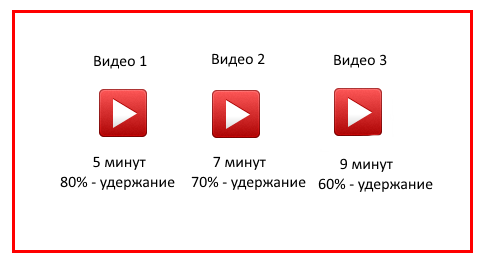
')
Perform your own test: enter all sorts of requests and check the duration of the clips in the top. Almost always it will be a long video.
Of course, the algorithm is much more complicated. For example, it takes into account what the user does after watching the video. If the video has a good hold, but after viewing it, users leave the site - this is a bad signal. If they start watching other videos (not even from your channel), then this is a positive signal and the video with the worst retention is ranked higher.
Conclusion : the video will be ranked well if it keeps people on Youtube. Do not be afraid to make long videos. The time a user spends on a site after watching a video may be more important than the total retention percentage.
When I started to promote videos in the issuance, I studied a lot of information on foreign and Russian-language blogs. Everywhere listed dozens of factors that affect the top. Initially, we tried to follow everything: optimize file names, ask people to add videos to their favorites, make long descriptions with lots of keywords, etc. But it didn’t bring any significant results. Yes, the natural traffic grew, but it was not possible to push any specific key to the top.
At some point, we realized that the withdrawal factors, voiced many years ago, are being repeated as true now. But YouTube is constantly changing its algorithm, and this simply can not be so that the keys in the file name and the re-optimized tags field still display videos in the first places.
Then we conducted a study and identified the following factors that influence the ranking of the video.
Organic traffic is very important. For some videos, it can be the main source of views. Therefore, in no case should they be neglected. In addition, search traffic is almost always the cheapest in the long term.
In general, SEO videos and sites are very similar. Also important are keywords, behavioral factors, linking, links. But there are differences, let's talk about them.
When collecting the semantic core of the site most often used Key Collector, Google keyword tool, Yandex Wordstat. But when collecting semantics for video, a request that is shown in the same Key Collector is not always the most effective. Why?
The fact is that Google gives different requests a different number of videos in the top. On some requests, the video may not be, but on others - the entire top of the video.
Consider a very simple example. Take a roller skate niche and 2 requests from it.

The first request is much more popular, it would seem much more profitable to sharpen video for it. But, if you look at the top of Google, we find that not a single position is allocated to the video!
Whereas in the top of the second request there is a video.

The example is very simple, but I think the point is clear.
Let's look at a slightly more difficult task on the example of one of our commercials.
Task: it is necessary to collect as many organic views as possible for the training video for the EC-7 tank ( https://www.youtube.com/watch?v=QBK-kGL53h4 ).
Let's start with the selection of keywords. Take the broad match from Wordstat:
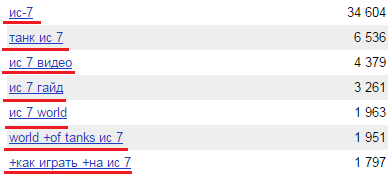
We eliminate commercial (because video training) and non-thematic requests. Next, we check through the Google Keywords Tool, and also we look at the number of allocated slots for the video.
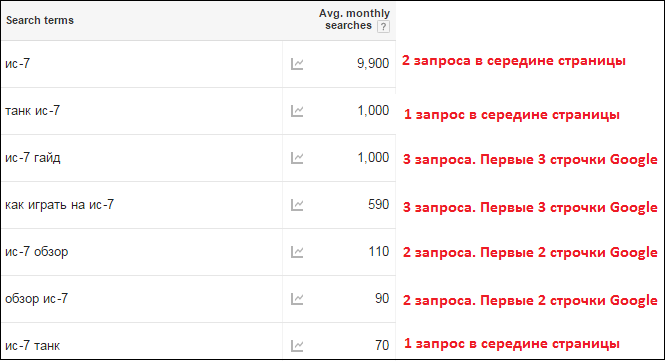
Next, we analyze the tips of Google and YouTube itself for the query "EC-7"
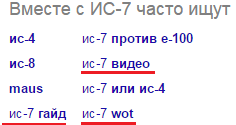
And YouTube tips:

We determine that it is advantageous to focus on the “guide” key. Video on this request is occupied by the first 3 lines of Google, Google itself and YouTube advise it, the key is well asked. In this case, the other keys are also good, and in no case should we exclude them from promotion.
As a result, we include everything in the name and description, while the most natural:

As a result, for all the keywords in Google and YouTube, the video took top positions. According to the main key "IS-7" it is also ranked highly.
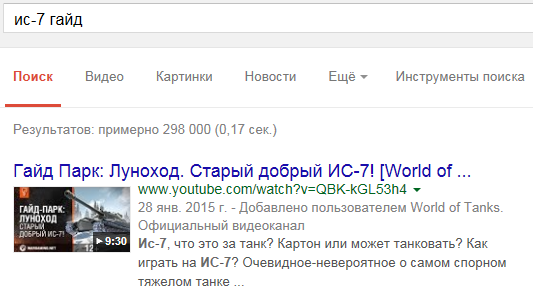

Conclusion: Consider all the ranking factors, and also correctly select keywords and descriptions. This will bring your videos to the top and collect organic traffic. Most importantly, remember that the process of collecting semantics for video has its own characteristics.
My name is Zhenya Zaremba. I work in Wargaming video promotion specialist. In this article I would like to talk about the promotion of videos on YouTube, promotion schemes and the nuances that occur during the work. We have conducted many tests and I will be happy to share their results with you. Under the cut, I will tell you all about the main success factors of the video, SEO features on YouTube, work with analytics and other techniques.

Retreat . We do not know 100% how the YouTube algorithm works. We did not create it and did not communicate with those who created it. We only analyzed a huge sample of videos and conducted tests. Fortunately, we have a lot of videos. Perhaps somewhere our conclusions are wrong. I will be happy to talk with anyone who has expertise in this area or my own thoughts on how to successfully promote videos
The main indicator in the promotion of video
Let's start with the most basic indicator, about which they write in all blogs and speak at any conference - retaining the audience. Audience retention is a percentage characteristic. It shows how many people watched your video to the end. The higher the percentage, the more interesting the movie is to the viewer. It is unlikely that you will watch until the end of a 10-minute video, if it is nonsense. Conversely, if the video is great, then you are more likely to watch it completely. Audience retention is the main metric of YouTube (but far from the only one), which affects a variety of indicators.
I have heard and read a lot of places where you need to make short videos, since the retention in them will be higher. This is logical. For example, a chair review in 30 seconds will see a lot more people through to the end than the same 10-minute review.
But is this the best option for YouTube itself? Let's try to look at the videos from his point of view. YouTube makes money by advertising. The longer a person is on the site, the more likely the interaction with advertising.
Then what is more profitable for him, a 2-minute video with 80% retention? Or 30 minutes, which will be watched to the end only 50%? Of course, 30 minutes, because users will spend much more time on the site.
Let's try to pass the test. What do you think, what movie, other things being equal, will be ranked higher?

')
Answer to the question
Other things being equal, the third video will be ranked higher. In the first, the user spent an average of 4 minutes on YouTube, on the second 4.9 minutes, on the third 5.4 minutes. But if the retention of the third roller was 50%, then the second would have won.
Perform your own test: enter all sorts of requests and check the duration of the clips in the top. Almost always it will be a long video.
Of course, the algorithm is much more complicated. For example, it takes into account what the user does after watching the video. If the video has a good hold, but after viewing it, users leave the site - this is a bad signal. If they start watching other videos (not even from your channel), then this is a positive signal and the video with the worst retention is ranked higher.
Conclusion : the video will be ranked well if it keeps people on Youtube. Do not be afraid to make long videos. The time a user spends on a site after watching a video may be more important than the total retention percentage.
Roller Ranking Factors
When I started to promote videos in the issuance, I studied a lot of information on foreign and Russian-language blogs. Everywhere listed dozens of factors that affect the top. Initially, we tried to follow everything: optimize file names, ask people to add videos to their favorites, make long descriptions with lots of keywords, etc. But it didn’t bring any significant results. Yes, the natural traffic grew, but it was not possible to push any specific key to the top.
At some point, we realized that the withdrawal factors, voiced many years ago, are being repeated as true now. But YouTube is constantly changing its algorithm, and this simply can not be so that the keys in the file name and the re-optimized tags field still display videos in the first places.
Then we conducted a study and identified the following factors that influence the ranking of the video.
The most important:
- Retention of the audience . Long rollers (10+ minutes) with good retention are much easier to bring to the top.
- Optimized title and description . How to pick up the keys talk a little later. They should appear in the title and in the first lines of the description. The description should be made as long as possible and, obviously, completely unique.
- Video views . YouTube cannot ignore videos that many people have watched. In addition, there is a separate filter in the issue "by the number of views." Many use it. But here it is important to remember that cheating will not lead to anything good. If you buy views with bots, then the hold will fall, and the movie will not go to the top.
Other factors:
- Number of likes and dislikes . And also their ratio to each other and views. Not so long ago, this was a pretty strong factor, but now it is winding up for a penny. 1000 likes can be bought for a couple of dollars. Now YouTube takes into account only natural likes (i.e., likes from users who watched the video, commented or otherwise showed their livelihoods). Just like without interaction with the video does nothing.
- Subscribers after viewing (or during) . It has an impact, but only if the subscriber has interacted with the content.
- Sharing and adding to favorites . These factors are also easy to wind up, so they will bring a plus only if after sharing the interaction in the social network occurs. In other words, if the video has received 100 tweets, but they have not brought visitors - cheat. If he received 100 tweets, they were retweeted and new visitors arrived - a positive signal for YouTube.
- Embedding videos on visited sites . If there are views from third-party sites - a uniquely positive signal for YouTube. The same happens with external links from good sites.
- The name of the file . The influence of this factor, I do not notice. But from the fact that you call a video with a certain key word, there will definitely not be any worse.
YouTube and Google SEO. We select semantics.
Organic traffic is very important. For some videos, it can be the main source of views. Therefore, in no case should they be neglected. In addition, search traffic is almost always the cheapest in the long term.
In general, SEO videos and sites are very similar. Also important are keywords, behavioral factors, linking, links. But there are differences, let's talk about them.
Keywords keywords
When collecting the semantic core of the site most often used Key Collector, Google keyword tool, Yandex Wordstat. But when collecting semantics for video, a request that is shown in the same Key Collector is not always the most effective. Why?
The fact is that Google gives different requests a different number of videos in the top. On some requests, the video may not be, but on others - the entire top of the video.
Consider a very simple example. Take a roller skate niche and 2 requests from it.

The first request is much more popular, it would seem much more profitable to sharpen video for it. But, if you look at the top of Google, we find that not a single position is allocated to the video!
Whereas in the top of the second request there is a video.

The example is very simple, but I think the point is clear.
Own example
Let's look at a slightly more difficult task on the example of one of our commercials.
Task: it is necessary to collect as many organic views as possible for the training video for the EC-7 tank ( https://www.youtube.com/watch?v=QBK-kGL53h4 ).
Let's start with the selection of keywords. Take the broad match from Wordstat:

We eliminate commercial (because video training) and non-thematic requests. Next, we check through the Google Keywords Tool, and also we look at the number of allocated slots for the video.

Next, we analyze the tips of Google and YouTube itself for the query "EC-7"

And YouTube tips:

We determine that it is advantageous to focus on the “guide” key. Video on this request is occupied by the first 3 lines of Google, Google itself and YouTube advise it, the key is well asked. In this case, the other keys are also good, and in no case should we exclude them from promotion.
As a result, we include everything in the name and description, while the most natural:

As a result, for all the keywords in Google and YouTube, the video took top positions. According to the main key "IS-7" it is also ranked highly.


Conclusion: Consider all the ranking factors, and also correctly select keywords and descriptions. This will bring your videos to the top and collect organic traffic. Most importantly, remember that the process of collecting semantics for video has its own characteristics.
What is important to know when promoting a video?
- A set of views . It is important to score the maximum number of views in the first 2-3 days. This increases the chance of video getting into category tops, right down to the main page.
In general terms, everything is trivial: if there is a budget, it is better to order sowing. If there is no budget, then use all available means: social profiles. networks, their sites, newsletters, etc. - Work with annotations and cards . Annotations are a very powerful tool for achieving any KPI that a video faces: pick up subscribers, bring people to the site, improve some behavioral factor, etc.
- Calls to action, communication with the audience . If in the description, annotations or comments to ask the person to do some action (like, comment, share), the result will not leave itself to wait. It is very important to maintain a dialogue with the user, because it is not only a good signal for Youtube. It also helps to get to know your user and make future videos cooler. For example:
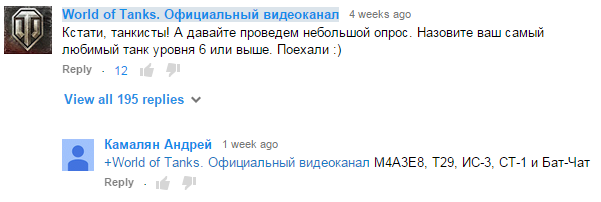
Active communication helps to find new ideas, find out what is interesting to the audience, and also increases loyalty to the channel.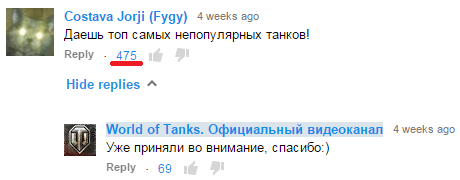
Tags This item I specifically moved here from the SEO section. Despite the obvious correlation, the tags have a greater influence on the location of your video in the "Recommended Videos" column. Each video should have the following tags:
• General channel tags. Repeat in all videos.
• Common gear loop tags. Repeat in specific programs.
• Unique tags specific video. Unique to each video.
Example: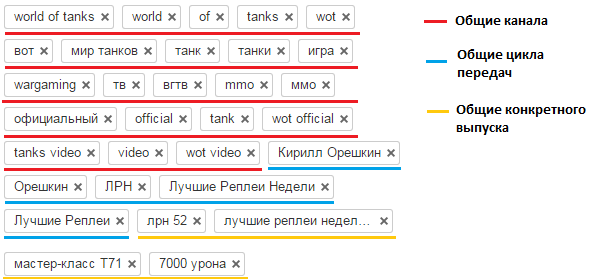
Thumbnails . A few months ago I wrote about the importance of choosing the “right” miniature. We conducted A / B tests and found options with maximum conversion for ourselves. Here is what you should pay attention to when choosing a thumbnail:
• Large text. It works well, because in recommended videos and on mobile phones it reads well. But remember, if you plan to advertise a video through Facebook, the caption should not take up more than 20% of the miniature.
• Do not make irrelevant miniatures (for example, with girls on technical video). This will lower the retention of the video, and it will drop in the issue.
• Place people in miniatures. People work best. And people with emotions on their face are even better.Work with analytics
When you have several videos, it's time to start working with analytics. You can learn a lot from analytics. For example, here are some YouTube audit cases that are fully obtained when working with analytics. In this article, we will consider two main indicators:- Hold
- Realtime
Hold
The retention report helps you understand which types of videos work well and are interesting for the audience and which are not. Take two reports:

The first graph shows that most people left almost immediately. Their video is not hooked. But almost everyone who watched the first minute looks to the end. It can be concluded that the video is interesting, but only for a certain part of users. Well, or change the beginning, because it does not interest the viewer.
The second graph shows that the video is interesting to the audience. Relevant shows, a good start, no sudden drops. Perhaps you need to slightly modify the end of the video.
There are two types of reports on hold in analytics:- Absolute Retention. It shows how the interest in the video falls during the viewing, comparing the number of people in a given review with the total number of views.
- Relative Retention. It compares your video with other videos with the same length, shows interesting moments, etc.

The example shows that there are jumps. This means that people return to this place after viewing for some reason. There is something interesting or controversial.Realtime
Realtime shows how users interacted with your video in the last 48 hours. For example: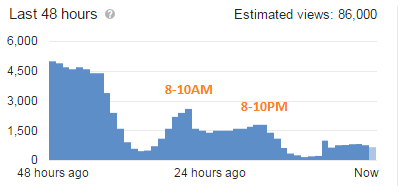
We see that this type of video is watched in the morning, then the views fall and after lunch begin to grow until the evening. In the evening, a sharp drop again.
Or another example:
Here we see that the views are growing from morning to evening.
Analyzing such reports, one can understand when it is better to release a video in order to get additional views in the first hours, etc.
Conclusion Promoting on YouTube is quite a difficult, but interesting task. There are dozens, if not hundreds of factors. There are many different schemes to attract traffic, and for free. If you are interested, I will definitely share them. Or you can read about all the research in my blog .Additional exampleSome channels use the “newbie bonus” for videos. The bottom line is that a new video gets a bonus when ranking and is issued higher within a few days.
Channels that cannot enter the top using the traffic key, collect traffic through it, constantly releasing new videos. A new video takes place in the top of the previous one. And as a result, some of the videos of this channel are always at the top.
Source: https://habr.com/ru/post/293070/
All Articles